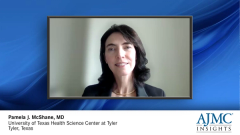
Indicators Leading to Bronchiectasis Testing and Diagnosis
Notable signs and symptoms distinguishing bronchiectasis from other pulmonary disease states are discussed.
Episodes in this series

This is a video synopsis/summary of an Insights involving Mark Metersky, MD, FCCP, on the diagnosis of bronchiectasis.
Most patients sent to specialty centers for bronchiectasis already have the diagnosis from CT imaging. The main diagnostic issue is identifying patients who warrant getting a CT scan to diagnose bronchiectasis earlier. Patients generally have chronic cough, usually productive with chronic purulent sputum from bacterial infection. These symptoms should prompt consideration of bronchiectasis and obtaining a CT scan. Other clues are exacerbations with chest pain or hemoptysis, which are more common in bronchiectasis than chronic obstructive pulmonary disease (COPD) or asthma. Delayed diagnosis often occurs because symptoms can mimic COPD and asthma. However, the history of chronic colored sputum production differentiates bronchiectasis. Even COPD patients with daily cough usually only have purulent sputum during acute exacerbations rather than daily.
Additional factors that should prompt an evaluation for possible bronchiectasis include underlying diagnoses like immunodeficiencies and certain autoimmune diseases. Severe COPD and asthma can also cause secondary bronchiectasis from chronic airway inflammation. For patients with existing COPD and asthma diagnoses, new onset increased cough frequency and sputum production or purulence could indicate development of bronchiectasis as a complication of the underlying lung disease.
Distinguishing COPD and asthma from primary bronchiectasis relies on key historical details. COPD rarely occurs without smoking history. Nonsmokers with chronic cough, sputum production, and wheezing need alternate diagnoses exclusion. Asthma typically starts in childhood or early adulthood, often with family history of atopy. Late adult-onset asthma-like symptoms without atopy risks warrants evaluating for bronchiectasis. Ultimately, the development of increased cough and sputum volume/purulence in known asthmatics or COPD patients should prompt consideration of secondary bronchiectasis. Identifying bronchiectasis can allow therapy modifications to improve outcomes.
Video synopsis is AI-generated and reviewed by AJMCÒ editorial staff.
Newsletter
Stay ahead of policy, cost, and value—subscribe to AJMC for expert insights at the intersection of clinical care and health economics.
































































